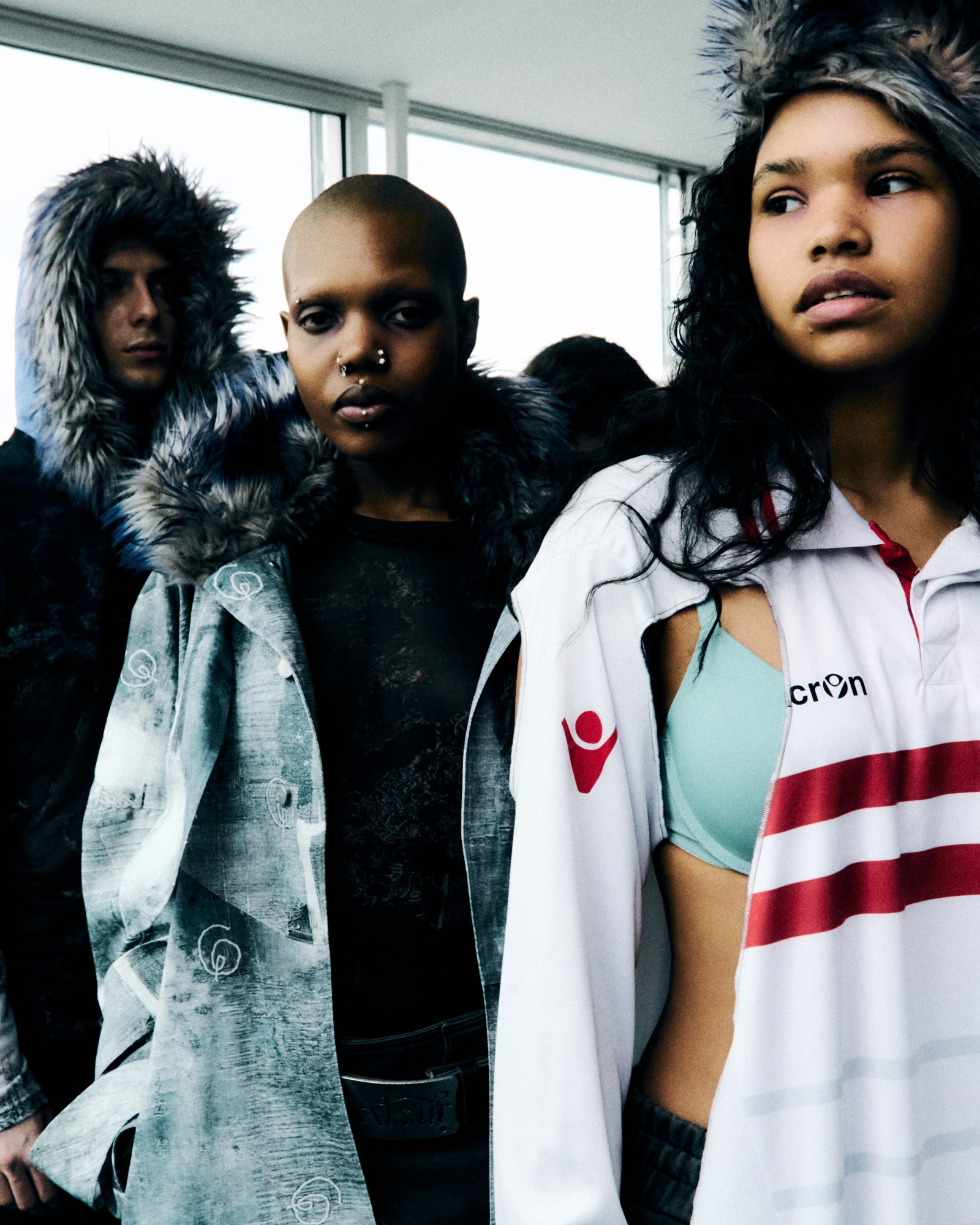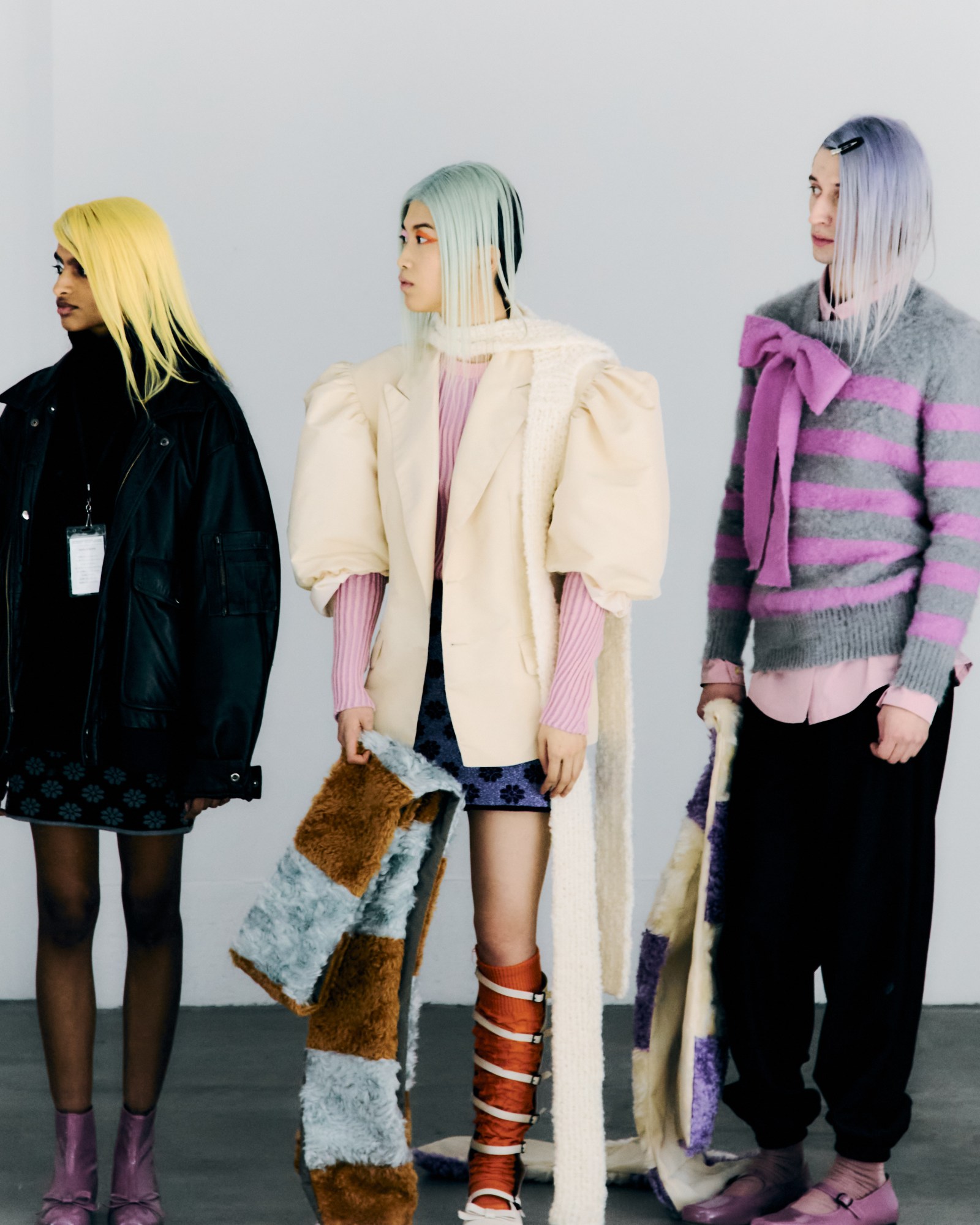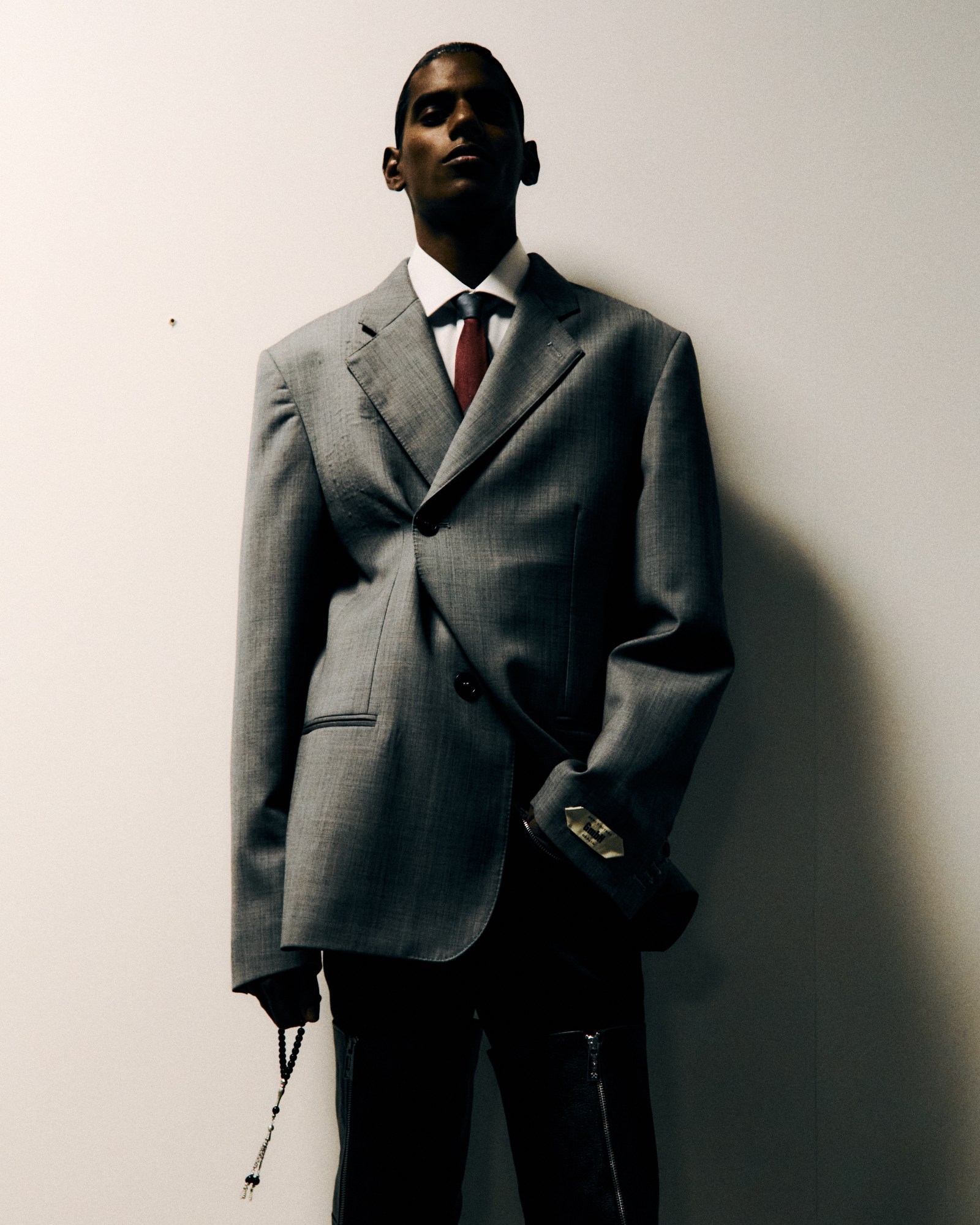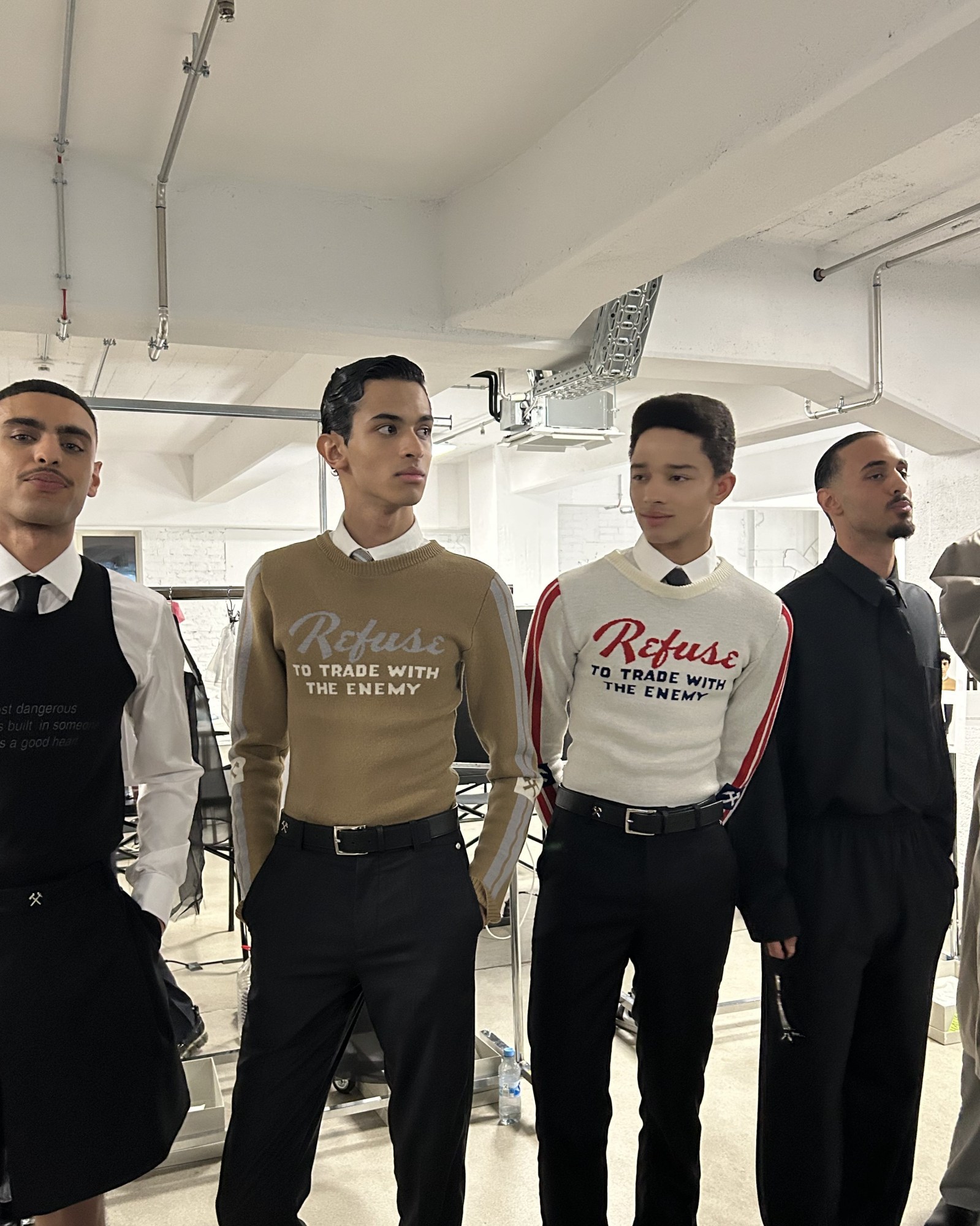A dark cloud lingered over Berlin Fashion Week at the recent Fall 2025 shows. Not the seasonally gray kind, which were also present, but the kind of clouds that bring on an ominous mood that permeated both the collections that debuted and the city itself. In the lead up to the German election taking place on February 23, several demonstrations against rising right-wing rhetoric blocked the passage of attendees while being ferried around to various shows over the weekend and political graffiti peppered posters and walls from Mitte to Charlottenburg.
Meanwhile, sombre soundtracks—from Alphaville’s “Forever Young” to a baby wailing—lamented while models padded past at a funeral pace at a couple of runway shows. In the collections themselves, though, any disorder or unrest was imperceptible. Sex, drugs, and techno—the Berlin you might know—were all in short supply this season too – the disruptive energy of Namilia and Shayne Oliver’s Anonymous Club notably missing from the schedule.
Now in its 18th year, this season of Berlin Fashion Week was a concerted effort to step out of the shadow of the Big Four (New York, London, Milan, and Paris) and go toe-to-toe with other smaller fashion week locations with larger international draws like Copenhagen or Seoul. The collections were bigger, the shows were longer, the locations were more impressive, and there was more international press present than ever before. In part, this is thanks to the Berlin Senate Department for Economic Affairs, Energy, and Public Enterprises—the department reportedly is injecting €2m per season to BFW, despite the government drastically slashing arts and culture funding by €130m elsewhere.
Broadening its horizons—“[For] the responsible movement of freedom, inclusion and creativity,” according to Fashion Council Germany— BFW also invited international designers to present their collections on the schedule. One of 19 brands on the calendar (a year ago, it was four) to clinch Berlin Contemporary funding to the tune of €25,000, PALMWINE IceCREAM founder Kusi Kubi was the sole Black designer on the show schedule, arriving in Berlin from Accra to present his first show outside of Africa.
“I’ve always loved Berlin, even before I had the chance to show my collection here. The city has an incredible way of allowing you to develop your own identity, which I find truly inspiring,” he says of the move. “I believe the energy of Berlin and PALMWINE IceCREAM are a perfect fit. Bringing those elements together has made this season a truly special one!” Navigating the cavernous concrete halls of Berghain, models wearing the brand’s signature hand-dyed deadstock leather, this time in burnt orange and magenta, appeared in cropped, tight-fitting clothes, ready to inject some color onto the monochromatic black dancefloors Berlin is known for.
German designer Marie Lueder, another Berlin Contemporary recipient, returned to Berlin to present the first half of her FW25 collection; the other will debut in London on February 21. Among “social anxiety”-printed socks, oddly chic pointed elf shoes, and signature fuzzy accessories, you’ll have likely seen her “Men are so BACK” tee on social media and immediately rolled your eyes. Understandable without context. “The horror of men is so back, especially Donald Trump,” the designer clarified backstage after the show. What about the ominous drones that whirred up and down the runway, a carpet printed with distorted CCTV mugshots or “ghosts” as she called them—eyes wide in horror or grinning menacingly? “We called it friendly stalking,” she explained. “The fear being observed and the information you’re giving to everyone constantly.”

The Lueder show was also on the roster for this season’s “Intervention” an event now in its third iteration curated by Reference Studios founder and CEO Mumi Haiati to bring a new energy to the schedule. “Berlin Fashion Week for too long has looked like a marketing initiative with a focus on clienteling,” he explains. “It’s time to give back and do things differently. We are very glad to contribute to the change.” Amid jazz performances and workshops, the lynchpin was a quartet of shows including debuts from newcomers Andrej Gronau and Kasia Kucharska and the second show from GmbH designers Benjamin Huseby and Serhat Işık since returning to Berlin last year.
Backstage, the duo appeared more reticent around discussing politics—unlike their impassioned speech for peace in Palestine following their FW24 show presented in Paris—but it wasn’t difficult to read between the lines. Discarded collection titles in the show notes, among them “In a Year of a Thousand Heartbreaks,” “Schadenfreude,” and “Cries & Whispers” revealed their sentiment. In the end, the pair settled on “From Another Reality” sharing its name with the title of the 1947 poem by Gunvor Hofmo. “It feels like we live in parallel worlds,” Huseby explained of the choice. “We see the same things, but we don’t experience the same reality. We wanted to acknowledge that and mirror it in a physical way.”
Instead letting the show do the talking, models emerged from two sides of the show space—a muslin-draped level of an abandoned car park—travelling opposite routes before exiting through the alternate doorway. Split into two halves, a reading of the Hofmo poem acted as the intermission. Alongside GmbH staples—razor-sharp boxy tailoring and over-the-knee leather stompers—slogans like “Refuse to trade with the enemy” and “The most dangerous anger is built in somebody who has a good heart” appeared on sweaters and vests. Other models clutched misbaha prayer beads, while delicate organza veils and tunics floated by.

“Many people are finding it very hard. The culture funding being drastically cut will change Berlin a lot over the next few years,” Işık offered post-show on the realities of living in Berlin as a creative. “There has also been a massive crackdown on so many artists that are being cancelled. It’s not just terrifying for the artists and creatives living here, but also sends a very strong message to a younger generation looking towards Berlin.”
Despite this, burgeoning homegrown talent is still managing to take root in the form of Haderlump and Richert Beil. Presenting collections back to back—both to packed-out rooms of fans—it was easy to picture their collections of latex, leather, and dark-wash denim walking right off the runway and straight onto the streets of Berlin.
And the city still remains a draw for international names like French brand Lou de Bètoly and Sia Arnika too. Nodding to her Danish roots, Arnika’s collection “Harbor Bitch” was staged around kilos of algae carted from her birthplace on the remote island of Mors by her parents while the collection featured twisted draping, bulbous silhouettes, and platform waders.
After debuting at BFW two years ago, what keeps her coming back? “Berlin is moving a little bit towards being more relevant, but it still has a grunginess to it and that fits a bit more. It’s difficult at the moment because funding is being cut and everybody has to go above and beyond to create something,” she reflects, pausing for a moment. “but I couldn’t see myself anywhere else.”

